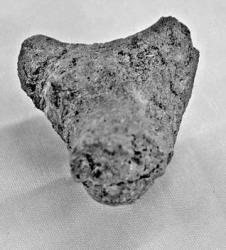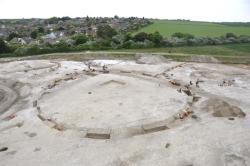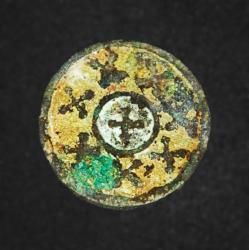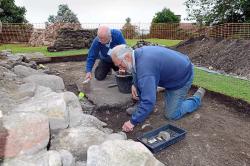INSTITUT SUPERIEUR D'ANTHROPOLOGIE
INSTITUTE OF ANTHROPOLOGY
ONLINE COURSES / COURS A DISTANCE
FALL TERM : OCTOBER 2015
REGISTER NOW
INDE -  Mandripattinam - Based on the findings unearthed during an archaeological excavation at Mandripattinam fishing hamlet in Thanjavur district, experts from the Department of Maritime History and Marine Archaeology of the Tamil University here posit the existence of a flourishing port town there during the Sangam era (Third Century Before Common Era to Third Century Common Era) and the Middle Chola period (850 to 1,250 Common Era). Sharing the information gleaned at the excavation expedition centred around Mandripattinam with The Hindu , director of excavation S. Rajavelu said that three shallow trenches with depth ranging from 50 to 100 cm were dug at specific spots in Mandripattinam. Further, four trenches were dug at Sendhalaipattinam, one km north of Mandripattinam, and one in Subbamma Chatram on the outskirts of Mandripattinam in July and August. All the areas are close to Adirampattinam in Thanjavur district. One of the trenches at Sendhalaipattinam yielded eight Ceylon Man type copper coins of the Middle Chola vintage. A silver Pana coin belonging to the Vijayanagar Empire was also found in a trench there, according to Mr. Rajavelu. The excavators were pleasantly surprised to stumble on a square lead coin having punch marks of an elephant on the obverse and a bow on the reverse side. Experts opine that these finding indicate the existence of a thriving port town during the beginning of the Common Era. The trenches in all the spots also yielded more than 600 tiny semi precious stones of various types and hues. Stunningly, several of the mustard-sized stones had still smaller hole in them to allow thread to form a necklace. A piece of a pretty thin metal string was also recovered nearby revealing the astute and intricate hand craft ability of the artisans of the yonder age. There was also a terracotta figurine of an ox head and a snake hood dating back to the medieval period among the recoveries at the trenches. At Sendhalaipattinam, the excavators also found the remnants of a mud wall at the floor level, a huge water pot and an indigenous water purifying system using a series of pipes for at least 10 feet. A piece of core gold and a broke part of gold jewellery were part of the artefacts recovered from that hamlet, Mr. Rajavelu said.
Mandripattinam - Based on the findings unearthed during an archaeological excavation at Mandripattinam fishing hamlet in Thanjavur district, experts from the Department of Maritime History and Marine Archaeology of the Tamil University here posit the existence of a flourishing port town there during the Sangam era (Third Century Before Common Era to Third Century Common Era) and the Middle Chola period (850 to 1,250 Common Era). Sharing the information gleaned at the excavation expedition centred around Mandripattinam with The Hindu , director of excavation S. Rajavelu said that three shallow trenches with depth ranging from 50 to 100 cm were dug at specific spots in Mandripattinam. Further, four trenches were dug at Sendhalaipattinam, one km north of Mandripattinam, and one in Subbamma Chatram on the outskirts of Mandripattinam in July and August. All the areas are close to Adirampattinam in Thanjavur district. One of the trenches at Sendhalaipattinam yielded eight Ceylon Man type copper coins of the Middle Chola vintage. A silver Pana coin belonging to the Vijayanagar Empire was also found in a trench there, according to Mr. Rajavelu. The excavators were pleasantly surprised to stumble on a square lead coin having punch marks of an elephant on the obverse and a bow on the reverse side. Experts opine that these finding indicate the existence of a thriving port town during the beginning of the Common Era. The trenches in all the spots also yielded more than 600 tiny semi precious stones of various types and hues. Stunningly, several of the mustard-sized stones had still smaller hole in them to allow thread to form a necklace. A piece of a pretty thin metal string was also recovered nearby revealing the astute and intricate hand craft ability of the artisans of the yonder age. There was also a terracotta figurine of an ox head and a snake hood dating back to the medieval period among the recoveries at the trenches. At Sendhalaipattinam, the excavators also found the remnants of a mud wall at the floor level, a huge water pot and an indigenous water purifying system using a series of pipes for at least 10 feet. A piece of core gold and a broke part of gold jewellery were part of the artefacts recovered from that hamlet, Mr. Rajavelu said.
http://www.thehindu.com/news/national/tamil-nadu/excavations-reveal-existence-of-thriving-port-town-in-sangam-era/article7639595.ece
USA –  Sitka - New evidence that may be related to a Russian shipwreck over 200 years ago has been found at an Archaeological work near Sitka this summer. In 1813, a Russian-American Company frigate, Neva wrecked somewhere near Cape Edgecumbe. In the wreck, 26 passengers and crew survived and made a crude camp on shore. They stayed in the camp for around a month before being rescued. McMahan and other archaeologists found a collection of Russian axes in a 2012 dig at the suspected site of the Neva survivors’ camp and in this past July, they discovered more artifacts.
Sitka - New evidence that may be related to a Russian shipwreck over 200 years ago has been found at an Archaeological work near Sitka this summer. In 1813, a Russian-American Company frigate, Neva wrecked somewhere near Cape Edgecumbe. In the wreck, 26 passengers and crew survived and made a crude camp on shore. They stayed in the camp for around a month before being rescued. McMahan and other archaeologists found a collection of Russian axes in a 2012 dig at the suspected site of the Neva survivors’ camp and in this past July, they discovered more artifacts.
http://uncovermichigan.com/content/25468-archaeological-work-near-sitka-turns-new-evidence-may-relate-russian-shipwreck
ROYAUME UNI –  Wessex - In 2010, the largest excavation in Britain took place on the Isle of Thanet in advance of construction of a new road, the East Kent Access Phase 2, providing improved access to Ramsgate and Sandwich. The route crossed three ‘landscape zones’, from the low lying Ebbsfleet peninsula − up to medieval times largely surrounded by water, to the Cliffsend spur overlooking Pegwell Bay, and finally up on to the high ground of the chalk ridge, with views cross the Wantsum Channel and beyond. Prehistoric highlights among the numerous archaeological discoveries include 12 Early−Middle Bronze Age barrows, a cluster of Late Bronze Age−Early Iron Age metalwork hoards, and two major but very different Iron Age settlements. This site will be presented by Phil Andrews at the Kent Conference this weekend. He will review, in particular, the chronological range and nature of the prehistoric discoveries, how their distribution might relate to the ‘landscape zones’, and consider the changes that took place over four millennia in this archaeologically rich island.
Wessex - In 2010, the largest excavation in Britain took place on the Isle of Thanet in advance of construction of a new road, the East Kent Access Phase 2, providing improved access to Ramsgate and Sandwich. The route crossed three ‘landscape zones’, from the low lying Ebbsfleet peninsula − up to medieval times largely surrounded by water, to the Cliffsend spur overlooking Pegwell Bay, and finally up on to the high ground of the chalk ridge, with views cross the Wantsum Channel and beyond. Prehistoric highlights among the numerous archaeological discoveries include 12 Early−Middle Bronze Age barrows, a cluster of Late Bronze Age−Early Iron Age metalwork hoards, and two major but very different Iron Age settlements. This site will be presented by Phil Andrews at the Kent Conference this weekend. He will review, in particular, the chronological range and nature of the prehistoric discoveries, how their distribution might relate to the ‘landscape zones’, and consider the changes that took place over four millennia in this archaeologically rich island.
http://www.wessexarch.co.uk/blogs/news/2015/09/11/barrows-hoards-and-settlements-prehistoric-discoveries-eka2?utm_source=feedburner&utm_medium=feed&utm_campaign=Feed%3A+wessexarchaeology+%28Wessex+Archaeology%29
BULGARIE –  Burgos - A previously unseen Early Christian bronze medallion is the most intriguing recent archaeological find from the excavations of the ancient fortress Burgos (Poros) on Cape Foros in the Bulgarian Black Sea city of Burgas. The medallion in question is the second notable Early Christian artifact discovered in the Burgos (Poros) Fortress in 2015, after in the spring the local archaeologists found there a lead reliquary containing ashes from the grave of St. John the Baptist. The medallion has been discovered during the excavation of a building from the 6th century AD, i.e. the Early Byzantine Period, in the Burgos (Poros) Fortress, Milen Nikolov, Director of the Burgas Regional Museum of History, has announced at a news conference in Bulgaria’s Burgas. The medallion was cast of bronze; it is round, and has a diameter of 3.5 cm. Its obverse features eight crosses, one of which is depicted in the middle, and the other seven are in its periphery. The central cross image was covered with white enamel, and the periphery – with yellow glass paste. The reverse of the Early Christian medallion discovered on Cape Foros has traces of wood which is taken to mean that it was attached to a wooden surface.
Burgos - A previously unseen Early Christian bronze medallion is the most intriguing recent archaeological find from the excavations of the ancient fortress Burgos (Poros) on Cape Foros in the Bulgarian Black Sea city of Burgas. The medallion in question is the second notable Early Christian artifact discovered in the Burgos (Poros) Fortress in 2015, after in the spring the local archaeologists found there a lead reliquary containing ashes from the grave of St. John the Baptist. The medallion has been discovered during the excavation of a building from the 6th century AD, i.e. the Early Byzantine Period, in the Burgos (Poros) Fortress, Milen Nikolov, Director of the Burgas Regional Museum of History, has announced at a news conference in Bulgaria’s Burgas. The medallion was cast of bronze; it is round, and has a diameter of 3.5 cm. Its obverse features eight crosses, one of which is depicted in the middle, and the other seven are in its periphery. The central cross image was covered with white enamel, and the periphery – with yellow glass paste. The reverse of the Early Christian medallion discovered on Cape Foros has traces of wood which is taken to mean that it was attached to a wooden surface.
http://archaeologyinbulgaria.com/2015/09/11/archaeologists-discover-early-christian-medallion-in-burgos-poros-fortress-in-bulgarias-black-sea-city-burgas/
G-B –  Oswestry - An archaeological dig on the top of the mound of Oswestry’s motte and bailey castle is only into its first few days yet it has already produced some fascinating results. The dig is part of ongoing work, now in its second year, led by archaeologist Roger Cooper. He said that it was now suspected that the eastern wall was not ‘in situ’ – that is the stones are not where they would have been originally. However, he said the western wall was now thought to be original. “We are beginning to suspect that we have found the wall edge and possibly evidence of rooms inside the castle walls,” he said. The castle is thought to have been built from wood before 1086. It was rebuilt in stone in the middle of the 12th century.
Oswestry - An archaeological dig on the top of the mound of Oswestry’s motte and bailey castle is only into its first few days yet it has already produced some fascinating results. The dig is part of ongoing work, now in its second year, led by archaeologist Roger Cooper. He said that it was now suspected that the eastern wall was not ‘in situ’ – that is the stones are not where they would have been originally. However, he said the western wall was now thought to be original. “We are beginning to suspect that we have found the wall edge and possibly evidence of rooms inside the castle walls,” he said. The castle is thought to have been built from wood before 1086. It was rebuilt in stone in the middle of the 12th century.
http://www.shropshirestar.com/news/2015/09/10/oswestry-archaeological-dig-revealing-secrets-hidden-for-centuries/
USA - St. Augustine - Archaeologists from the University of Florida are packing up at a dig site in St. Augustine, Fla., where they discovered a 17th century mission church. The church is believed to be part of the Nombre De Dios Mission, which was the longest lasting mission in the Southeast dating back to 1587, said Gifford Waters, a researcher for the Florida Museum of Natural History. Researchers said the building, made out of coquina stone and tabby foundations, is at least 90-by-40-feet large, making it one of the largest churches in colonial Spanish Florida, and the only mission church made out of stone. Waters and other researchers will take materials and notes back to UF to be recorded and examined. Waters said he hopes to get back to the site within one or two years to continue uncovering more information about this community.
VIDEO = http://www.wuft.org/news/2015/09/10/uf-archaeologist-discovered-17th-century-mission-church/